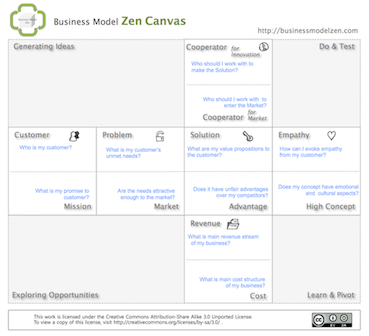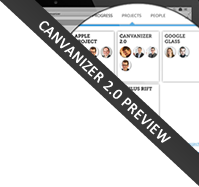The Business Model Zen Canvas was proposed by Cho, Yongho based on his book published on June 2013 in Korea: Business Model Zen.
Business Model Zen is business modeling methodology that builds upon the disciplines of customer orientation, strategic thinking and loop learning by execution. It is consolidation of the various researches on business models, since 2009, into the form of essential methodologies and toolkits. Business Model Zen provides a single logical frame where a business is systematically modeled and proactively managed, from idea to design and execution.
If you want to try it out without entering your email address, please use our public Business Model Zen Canvas Demo for a first impression.

More about the Business Model Zen Canvas
GENERATING IDEAS
The Business Model Zen Canvas is a great way of mapping out ideas, allowing it to be properly understood, experimented and developed. Ideas are important in innovation. Without ideas, there will be very little or nothing to execute, generating new ideas is important for making any kind of improvement. Idea generation means coming up with concrete or visual ideas.
This column is useful for noting down those ideas you have that can help develop your business.
CO-OPERATORS FOR INNOVATION
For a business to be deemed relevant, and for it to maintain its relevance, the business’s needs to innovate cannot be overemphasized. To develop and implement the ideas to innovate, you need to work together with co-operators, sharing knowledge to aid the process of development of the best possible products. This is why this column is important in the business model canvas as you can note the best possible bodies your business can cooperate with in order to innovate.
DO AND TEST
This column helps to identify the important activities that need practice before rollout, for example when a company specialized in consumer product wants to know how their product or new marketing campaign will perform, they do not only rely on surveys, they go directly to test markets. That is the best way to be informed on how the innovation work in real market conditions, without taking the bad risk of a national or global rollout.
CO-OPERATOR FOR MARKET
This column helps businesses to identify and visualize the bodies that can help them advance in the market relevant to their industry, this may include various forms of assistance to support activities that help your business to move forward and compete in the relevant markets.
CUSTOMER
A customer is someone or another company that receives, consumes or shops from your available product or service and can choose between different goods and suppliers. The main goal of all commercial enterprises is to attract customers or clients and make them purchase what they have on sale. This column helps to identify and take note of your key customers.
PROBLEM
This column helps to help you identify the needs of your customers. Problems are an important part of what many businesses experience every day. Businesses must constantly devise new methods of meeting the needs of their customers, and this section helps those who have identified and are already solving problems, or discovering new problems to solve.
SOLUTION
This is the value your business has to offer in response to your customer’s needs, it is a set of products, services, and intellectual property, focused on a specific business problem the consumer has.
EMPATHY
Empathy is defined by entrepreneur Joey Pomerenke as “the feeling that you understand and share another person’s experiences and emotions; and the ability to share someone else’s feelings”. This column in the business model zen canvas helps to identify and visualize these emotions.
MISSION
A mission statement defines what an organization is, why it exists, and its long term purpose. At the minimum, your mission statement should define who your primary customers are, identify the products and services you produce, and describe the geographical location in which you operate. This column helps to create a mission statement by writing down what the purpose of your business is.
MARKET
A market is a place where manufacturers, distributors or retailers sell, and consumers buy. Where the consumer transacts with the manufacturers and intermediaries. Businesses that operate in markets are usually in competition with other companies, this column helps to identify the market where your business operates.
ADVANTAGE
Advantage is the ‘upper hand’ a business has over its competitors in the same market. This can be derived from offering your clients better and greater value. Making adverts about your products or services with lower prices or higher quality that attracts the interest of consumers. What are your competitive advantages? Note them down using this column.
HIGH CONCEPT
A high concept pitch is a single sentence that effectively explains your company’s vision. In short form, it should be able to explain your company’s vision, where you plan to be in years to come.
EXPLORING OPPORTUNITIES
Getting involved in a bad business opportunity can be detrimental and discouraging. It's really difficult to find good business opportunities, and any successful CEO will tell you it took a while to get it right.
The best tactic is to note down opportunities and understand what to look for and where to go to find successful opportunities.
REVENUE
This helps to note down your business’s revenue streams, how your business generates its income. Revenue Streams are the way by which your business converts your Value Proposition or solution to the customer’s problem into financial gain.
COST
Cost is the amount that you have to pay or give up in order to get value in return. In business, cost is most times a monetary valuation of effort, infrastructure, resources, time and utilities consumed, risks incurred, and opportunity forgone in production and delivery of a good or service.
LEARN AND PIVOT
A pivot usually takes place when a business makes an important change to its operations after determining (most times through market research) that its product is not up to par with the intended market.
If you want to read more about Business Model Zen and the methodology you might want to check out the following links:
- Business Model Cube
- Business Model Zen Canvas
- Business Model Zen Diagnostics
- Business Model Zen Pattern (=4by4 Business Model Patterns)
- Business Model Map
- SOFT Ideation
- Blue Ocean Strategy
- User Centered Service Design
- Business Model Canvas
- Customer Developement
- Lean Startup

